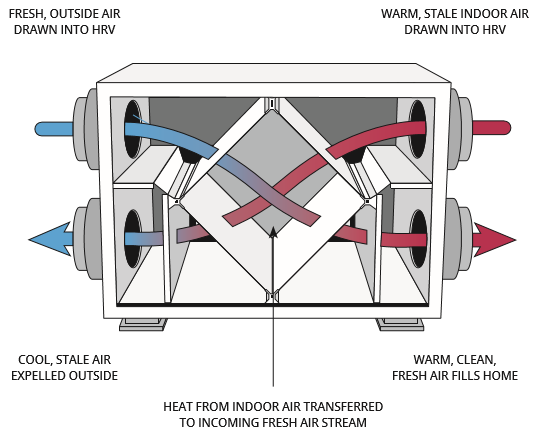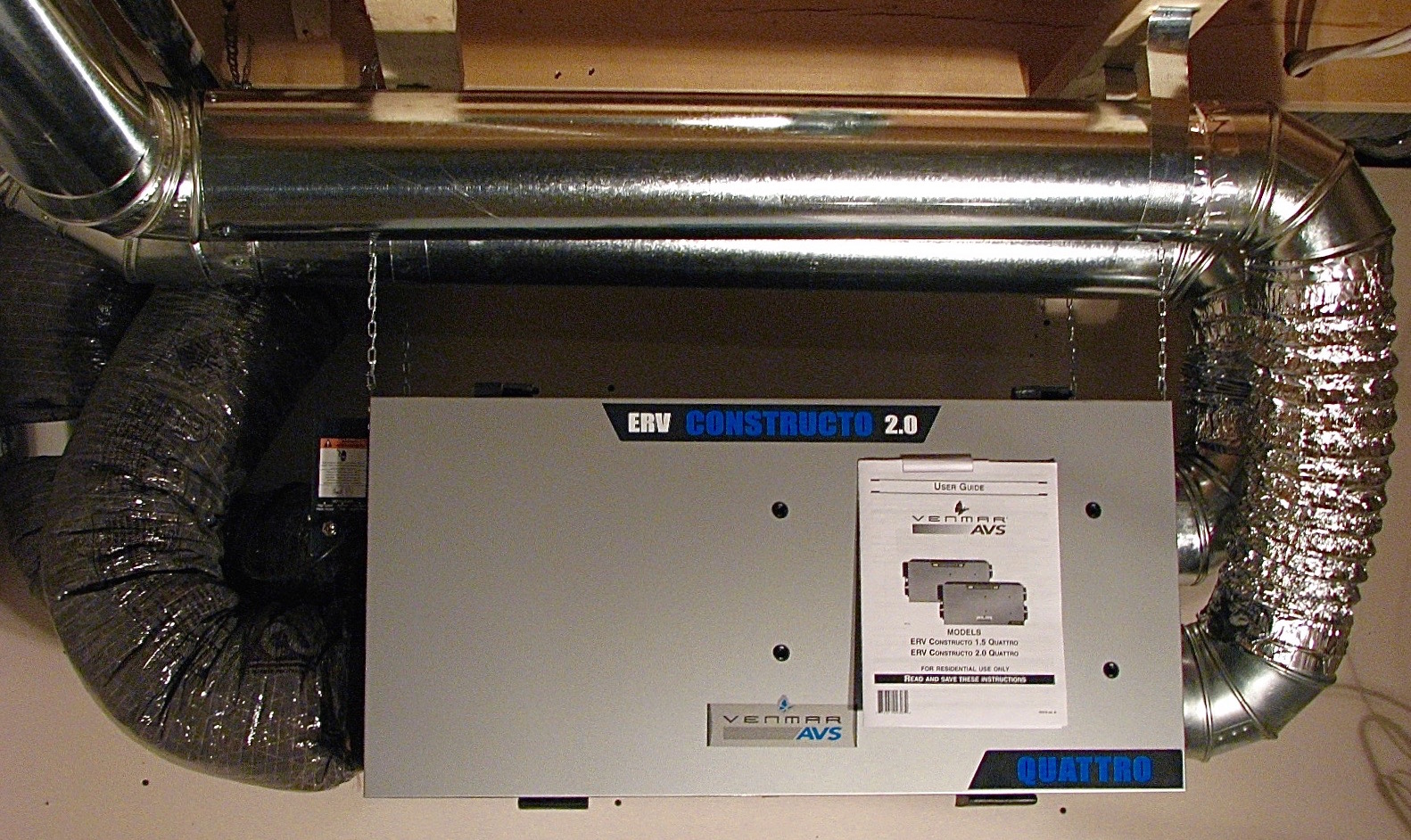Unveiling the Trick Conveniences and Uses of Heat Recovery Ventilation in Sustainable Design
Heat Recovery Ventilation (HRV) systems play a necessary function in sustainable style. They help with a continual exchange of stale indoor air with fresh exterior air, considerably boosting interior air quality. Moreover, HRVs add to power effectiveness by redeeming warm from tired air, which can lower energy prices. Understanding the complex benefits and applications of HRVs discloses their relevance in modern-day design. What various other benefits do these systems use in the search of sustainability?
Recognizing Heat Recovery Ventilation Equipments
Heat recovery ventilation (HRV) systems are designed to improve indoor air quality while minimizing energy loss. These systems use a mechanical ventilation technique to exchange stagnant indoor air with fresh exterior air, guaranteeing a continuous supply of clean air. By catching warm from the exhaust air, HRVs precondition inbound air, minimizing the need on heating and cooling down systems. This process not only enhances thermal convenience however likewise contributes to energy performance in property and industrial structures. In addition, HRV systems help manage moisture degrees and reduce interior pollutants, advertising a healthier living atmosphere. Their critical implementation is vital for achieving sustainable design objectives, as they provide an equilibrium between energy preservation and occupant well-being.
Exactly How HRV Equipment Work
While several may be acquainted with air flow systems, recognizing exactly how warm healing ventilation (HRV) systems run is essential for valuing their benefits. HRV systems function by trading stagnant indoor air with fresh outside air while moving warmth in between both streams. This process occurs in a warmth exchanger, where warm from the outbound air heats the incoming air during colder months, lessening power loss. On the other hand, in warmer months, the system can cool inbound air utilizing the cooler outbound air. HRVs are equipped with fans to help with air movement and filters to eliminate particulates, ensuring a constant, well balanced ventilation procedure. This ingenious style not just boosts power efficiency but likewise adds to keeping a comfortable interior atmosphere.
Enhancing Indoor Air Quality
Indoor air top quality can greatly affect wellness and well-being, making effective air flow vital in modern homes. Heat Recovery Ventilation (HRV) systems play an essential role in keeping indoor air high quality by continually exchanging stale interior air with fresh outside air. This procedure not only minimizes airborne toxins but additionally lessens moisture degrees, which can result in mold development and breathing issues. HRV systems filter inbound air, getting rid of allergens and particulates, therefore offering a much healthier living atmosphere. Furthermore, these systems aid get rid of odors and volatile natural compounds (VOCs) generally found in house products. By guaranteeing a regular circulation of tidy air, HRV systems add to an overall improved indoor environment, advertising comfort and health for owners.
Energy Efficiency and Expense Savings
Power performance stands apart as a substantial advantage of Heat Recovery Ventilation (HRV) systems. By recording and recycling the heat from exhausted interior air, HRVs minimize the power required for home heating inbound fresh air, bring about minimized energy consumption. This efficiency equates into reduced energy costs, using significant price savings for house owners and businesses alike. In addition, HRV systems usually get power efficiency rewards and discounts, better improving their economic allure. Gradually, the preliminary investment in HRV innovation can cause a favorable roi via reduced energy expenses. The assimilation of HRV systems not just advertises sustainable style but additionally supplies a sensible solution for accomplishing long-lasting energy cost savings and economic advantages.
Environmental Advantages of HRV

A plethora of ecological advantages develops from the implementation of Heat Recovery Ventilation (HRV) systems. By successfully transferring heat from exhaust air to inbound fresh air, HRVs substantially reduce the energy needed for home heating and cooling spaces. This power performance converts to reduce greenhouse gas emissions, adding to a decline in the general carbon footprint of buildings. In addition, HRV systems enhance interior air high quality by continually circulating fresh air, thereby lowering the concentration of interior pollutants and allergens. Additionally, the reduction in energy usage help in preserving natural sources, making HRVs a vital component of lasting style. Generally, the environmental benefits of HRVs play a vital duty in advertising a much healthier world and promoting environmentally friendly building techniques.
Versatile Applications in Modern Architecture
Heat recovery ventilation (HRV) systems are progressively being incorporated into both household and commercial architectural tasks. In domestic setups, HRVs improve interior air high quality while taking full advantage of power efficiency. In industrial rooms, these systems optimize ventilation methods, showing their versatility in modern building applications.
Residential Projects Integration
While contemporary style significantly stresses sustainability, the assimilation of warmth healing ventilation systems in household tasks has actually become a practical service for improving indoor air top quality and energy performance. These systems successfully transfer warmth from exhaust air to incoming fresh air, lessening energy loss and lowering heating or go to website cooling down demands. In brand-new builds and retrofits alike, warm healing ventilation can be effortlessly incorporated, giving homeowners with a healthier living setting while decreasing energy costs. Additionally, with increasing understanding of environmental impacts, even more engineers and home builders are identifying the lasting advantages of these systems. As an outcome, warm healing air flow has become an essential part of lasting household layout, showcasing adaptability and commitment to eco-friendly techniques.
Industrial Areas Optimization
As contemporary commercial rooms develop to fulfill the needs of sustainability and efficiency, the execution of warm healing air flow systems becomes a key approach for enhancing interior atmospheres. These systems assist in the exchange of stale interior air with fresh outdoor air while redeeming heat, significantly minimizing energy intake. This not only boosts comfort for occupants however also assists in reducing operational costs. Flexible applications can be observed in offices, retail areas, and universities, where air quality and temperature level control are vital. Additionally, integrating warmth recovery air flow straightens with eco-friendly structure certifications, additionally promoting environmental duty. Ultimately, embracing such systems in business architecture not only adds to sustainability goals yet also promotes much healthier, extra productive rooms for users.
Integrating HRV Into Sustainable Style Practices
Integrating heat recovery ventilation (HRV) systems right into lasting layout techniques uses significant benefits in energy performance and interior air top quality. By using HRV, designers can produce affordable options that not just minimize energy consumption but additionally boost the general convenience of indoor atmospheres. This try this site placement with sustainability objectives positions HRV as an essential part in modern-day architectural approaches.
Power Efficiency Enhancement
By including warmth recovery ventilation (HRV) systems right into sustainable style techniques, designers and home builders can considerably boost power performance in modern-day constructions. HRV systems function by recording warm from outgoing stagnant air and transferring it to inbound fresh air, reducing the power required for heating or cooling indoor areas. This procedure not only minimizes dependence on standard HVAC systems but also reduces general energy usage. On top of that, HRV systems can aid maintain a constant indoor temperature, lowering peak power needs. By integrating these systems, buildings can accomplish substantial decreases in energy costs and carbon impacts, aligning with sustainability objectives. Eventually, HRV innovation stands for a functional solution for website here enhancing energy performance in the built atmosphere, advertising more accountable source use.
Indoor Air High Quality Enhancement
How can warm healing air flow (HRV) systems contribute to remarkable interior air high quality in contemporary structures? HRV systems efficiently exchange stagnant interior air with fresh exterior air while recovering warm energy, decreasing temperature changes. This procedure reduces the concentration of interior contaminants, such as unstable natural substances (VOCs), irritants, and wetness, which can weaken air top quality and influence occupant health. By keeping excellent moisture degrees and guaranteeing a continuous supply of clean air, HRVs help develop a much healthier interior setting. On top of that, these systems can be incorporated right into lasting design practices, promoting energy efficiency alongside boosted air top quality. HRV Heat Recovery Ventilation. HRV modern technology plays a crucial role in advancing overall owner comfort and well-being in contemporary architectural layouts.
Cost-Effective Design Solutions

Often Asked Questions
What Maintenance Is Required for Heat Recovery Ventilation Equipments?

Maintenance for warm recovery air flow systems generally entails regular filter substitutes, cleaning of warm exchangers, examination of followers and air ducts, and making certain appropriate drain. These tasks assist preserve effectiveness and extend the system's life expectancy gradually.
Can HRV Equipments Be Set Up in Existing Buildings?
Heat recovery ventilation systems can undoubtedly be installed in existing buildings. HRV Heat Recovery Ventilation. Retrofitting requires careful preparation and evaluation of the structure's layout, ensuring compatibility with current systems while making the most of energy efficiency and interior air top quality
Just How Do HRV Systems Influence Noise Degrees Indoors?
HRV systems can influence indoor noise degrees by presenting audio from external sources with ventilation. Nonetheless, top notch installments usually incorporate sound-dampening functions, decreasing sound impact while offering effective air exchange and maintaining convenience inside.
Exist Any Kind Of Drawbacks to Using HRV Solutions?
The disadvantages of using HRV systems include prospective high initial costs, maintenance challenges, and the opportunity of lowered interior air quality if filters are not on a regular basis changed, which might lead to problems with moisture degrees.
Just how Do I Pick the Right HRV System for My Needs?
Selecting the right heat recuperation air flow system entails reviewing details demands, such as building size, environment, and power efficiency goals. Furthermore, evaluating system features, installation needs, and maintenance factors to consider is essential for peak performance and complete satisfaction.